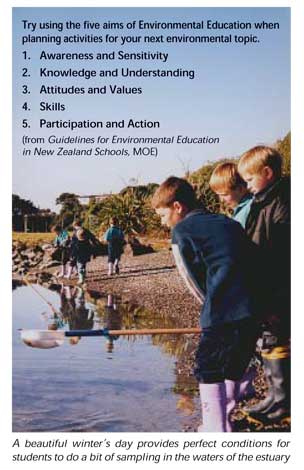| Our Environment: Issue 27 Winter 2001 |
Water – a most precious resource. When studying water it’s important to think not just about what comes out of the tap, but also what runs through the city in our many waterways -rivers, streams, creeks and drains.
 The city’s water facilities, waterways and wetlands provide a wonderful
context for delivering your water topic in terms of education in, about and for the
environment – the three dimensions of environmental education. There are great
opportunities for out-of-theclassroom-experiences when you are studying water whether you
are focusing on water supply, wastewater, or looking at the plant and animal life that
exists in our waterways and wetlands, and the impact we as humans are having on these
valuable ecosystems.
The city’s water facilities, waterways and wetlands provide a wonderful
context for delivering your water topic in terms of education in, about and for the
environment – the three dimensions of environmental education. There are great
opportunities for out-of-theclassroom-experiences when you are studying water whether you
are focusing on water supply, wastewater, or looking at the plant and animal life that
exists in our waterways and wetlands, and the impact we as humans are having on these
valuable ecosystems.
Sumner School’s Year 4 students discovered the wonders of the Avon-Heathcote Estuary during a visit to McCormack’s Bay last term, organised through the Council’s Environmental Education Programme for Learning Experiences Outside the Classroom. With a focus on “How people’s activities can have a damaging effect on natural and cultural features of the environment” (Social Studies, Place & Environment, Level 2: 1.3) the estuary, an important feature of their local environment, provided the perfect context for their unit of study.
In the classroom students had looked at what an estuary is, the special nature of estuarine water and identified plants and animals that live in this type of environment (EE Aim 2). In preparation for the visit the class was taken through an activity to look at ‘How to be great visitors to the estuary’, considering the environmental impacts they could have as visitors and how to reduce or eliminate these on the day (EE Aim 1).
The hands-on focus of the visit gave students the opportunity to learn safe sampling techniques in the water and ways to investigate life in the mud with minimal disturbance to the ‘residents’ (EE Aims 1 & 4). ‘Catch’ of the day included estuarine prawns and anemones, chitons, limpets, fan worms, barnacles, cockles, whelks, mud snails and crabs. To round off the experience the Catchment Activity had students tracing the path of the city’s water from the mountains to the sea, looking at what goes into our waters along the way and thinking of great ways they can improve the environment for life at the estuary ... and then picking one and doing it! (EE Aim 5)
Here’s what a couple of students thought they could do:
“I think I can help the
estuary by not washing cars with soap.”
“Next time I go to the estuary I will pick up lots of rubbish.”
| Water-related
Environmental Education Programmes for Learning Experiences Outside the Classroom
All programmes are led by experienced educators and provide hands-on experiences. Bookings are essential! To make a booking for:
|
| Our Environment Index |